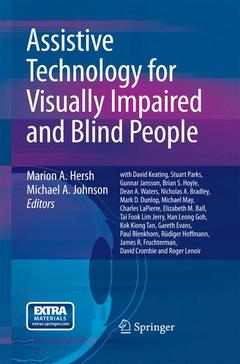Description
Assistive Technology for Visually Impaired and Blind People, 2008
Language: English
Subjects for Assistive Technology for Visually Impaired and Blind People:
Publication date: 09-2014
725 p. · 15.5x23.5 cm · Paperback
Publication date: 02-2008
800 p. · Hardback
Description
/li>Contents
/li>Biography
/li>Comment
/li>
Equal accessibility to public places and services is now required by law in many countries. It is often the use of specialised technology which can provide the vision-impaired with a fuller enjoyment of all the facilities of society. In this volume the engineering and design principles and techniques used in assistive technology for blind and vision-impaired people are explained.
Features: instruction in the physiology of the human visual system and methods of measuring visual ability; explanation of many devices designed for every-day living in terms of generic electrical engineering principles; sections of practical projects and investigations which will give the reader ideas for student work and for self teaching; contributions by authors of international repute from divers fields which co-operate under the banner of assistive technology, among them: artificial vision systems; psychology, haptics, electrical engineering, design and visual physiology.
Dr Hersh is currently a senior Lecturer in the Department of Electronics and Electrical Engineering, University of Glasgow. She was previously a lecturer in this Department. She has also held posts as a Post-doctoral Research Fellow at the Universities of Sussex and Strathclyde. She has now been researching in the area of assistive technology for about 12 years.
Her current research interests fall into four main areas:
• Assistive technology, particularly for people with sensory impairments.
• Ethics and Social Responsibility Issues in Science and Engineering.
• Good design practice, including the principles of sustainable and universal design, end user involvement and human centred design approaches.
• The research process.
She is continuing to run the successful CVHI conference series ‘Conference and Workshop on Assistive Technologies for People with Vision and Hearing Impairments’, which she initiated with Prof Mike Johnson of the University of Strathclyde. Funding for the first three events was obtained from the EC High-Level Scientific Conferences Programme and the current funding for three further events, of which one has already taken place. Distinctive features of this conference series include the support given to young researchers and the conference ambience which encourages networking.
Current research projects in the area of assistive technology include the development of a communication and interface device for deafblind people, distance learning for people with mobility impairments with colleagues from Germany, Hungary and Romania and travel support technology for blind people with colleagues from France. Having been a workaholic for most of her life, Dr Hersh has recently become aware of the importance of making leisure activities accessible. Research carried out for the book has confirmed the lack of technology to support the involvement of blind people in sport and other leisure activities. Research projects in this area inc

